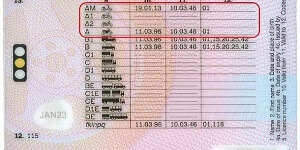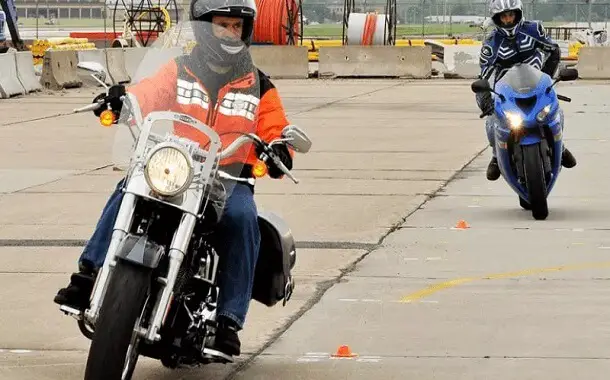Motorcycle License Cost
Last Updated on February 26, 2024
Written by CPA Alec Pow | Content Reviewed by ![]() CFA Alexander Popinker
CFA Alexander Popinker
Handling a motorcycle on the trail is not a job that everyone can do. It takes a lot of passion, combined with dexterity, to keep a two-wheeled vehicle under control.
Those who want to drive a motorcycle must obtain a motorcycle license. It is true that passing the exam requires a lot of solved questions, but theoretical preparation is not everything. In the following, you will find out a lot of interesting information for those who want to obtain their motorcycle license and successfully pass the exam.
How Much Does a Motorcycle License Cost?
The cost of a motorcycle license is greatly affected by the state you reside in. Be prepared to spend, on average, anywhere between $15 and $70 for a motorcycle license, without including your skills test and the different taxes required in order to get the license. When taking into account all the courses, road tests, and permit fees, the cost of a motorcycle license would be around $310.
In the table below you will find the average costs of a driving license in each state of the United States of America.
| State | Costs |
| Alabama | $5 testing + $23.50 license |
| Wyoming | $23 |
| Wisconsin | $22 |
| West Virginia | $10 |
| Washington | $25 |
| Virginia | $6 per year |
| Vermont | $2 to $8 for endorsement |
| Utah | $27.50 |
| Texas | $25 |
| Tennessee | $20.50 |
| South Dakota | $8 |
| South Carolina | $12.50 to $25 (depending on length) |
| Rhode Island | $26.50 |
| Pennsylvania | $31 |
| Oregon | $87 for 8 years |
| Oklahoma | $21.50 |
| Ohio | $25 |
| North Dakota | $5 |
| North Carolina | $15 for permit + $1.75 per year |
| New York | $23.50 for permit + 12.50 for license |
| New Mexico | $18 to $34 (depending on length) |
| New Jersey | $65 |
| New Hampshire | $30 |
| Nevada | $21.25 |
| Nebraska | $26.50 for first time |
| Montana | $40 |
| Missouri | $10 to $20 |
| Mississippi | $6 to $14 |
| Minnesota | $21 |
| Michigan | $13.50 |
| Massachusetts | $30 |
| Maryland | $72 |
| Maine | $10 exam + $30 license |
| Louisiana | $19 |
| Kentucky | $24 |
| Kansas | $9 to $12.50 |
| Iowa | $12 to $30 |
| Indiana | $11 to $24 (depends on age) |
| Illinois | $10 |
| Idaho | $13 tests + $15 license |
| Hawaii | $10 to $40 (depending on length) |
| Georgia | $20 to $32 (depending on length) |
| Florida | $33 |
| Delaware | $8 |
| Connecticut | $40 exam + $15 permit |
| Colorado | $23 |
| California | $28 |
| Arkansas | $20 |
| Arizona | $10 to $25 (based on age) |
| Alaska | $20 |
Note: This cost is available for the license alone and will not include any permit, testing, and extra fees which your state may ask for.
Motorcycle license: short presentation
 The process of obtaining a motorcycle license is almost the same as for a driver’s license. You will have to pass a written test and a road test to demonstrate your skills.
The process of obtaining a motorcycle license is almost the same as for a driver’s license. You will have to pass a written test and a road test to demonstrate your skills.
The first step you need to take for obtaining a motorcycle license is to apply for a learner’s permit. There is a minimum age requirement for all states and it will vary from one state to another. Also, depending on this, the waiting period before you will be able to apply for your license may be anywhere between twenty days and six months. While using your learner’s permit you will have to meet the minimum speed requirements imposed by the state you leave in.
You might also like our articles on the cost of an international driver’s license, TWIC card, or NASCAR race and car driving experience.
You will visit your local agency when you consider that you are ready. At this point, you will have to fill out an application and pay for the fees presented above. After that, you will be asked to verify your motorcycle registration, license plates, and insurance. Once approved, there will be set a day for your road test. Also, before receiving your license, you may be asked to take a written test, if it is considered necessary.
Finally, after you pass the test a motorcycle endorsement will be added to your driver’s license.
What kind of motorcycle equipment do you need?
Equipment is especially important for two-wheelers because it can make the difference between life and… worse. Whether the motorcycle protective equipment you have is the most basic or top-of-the-line, it must be complete.
At a bare minimum, the motorcycle equipment must be composed of:
Helmet
The helmet is the most important part of the protective equipment, and when purchasing it, you should not try to save money. The purpose of the helmet is both to reduce the risk of serious head injury by absorbing the energy created in an accident and reducing the force of impact, and to provide face protection. Indeed, a good motorcycle helmet costs quite a lot, but it is an investment well made.
Don’t buy a motorcycle helmet online; go to the store and try it on! You need to make sure that it is fixed and that there are no uncomfortable pressure points.
Trousers (provided with protection) or knee pads
They offer increased protection compared to any normal trousers and generally have protection in the hip and knee area. Most models have specially reinforced areas with additional protective Kevlar material. It is important that the trousers include protection or have special inner pockets for fitting them.
Motorcycle boots or any other rigid boots that cover your ankles
Footwear should be rigid-soled, with at least toe and heel protectors. The material can be leather or textile, waterproof Kevlar, etc. Whatever you choose, it is important that the footwear also protects the ankle in case of falls, bumps, or knocks.
Gloves
An element of motorcycle equipment that often tends to be overlooked, but is just as important as the rest. There are types of gloves adapted to each type of motorcycle (supersport, touring, chopper, enduro). Protections can differ in appearance, material, and complexity.
Jacket (provided with protection) or armor
You can go for textile or leather motorcycle jackets. Recently, jackets made of textile material are gaining ground, considering their versatility, the high level of protection in case of an accident, the lower weight, and the fact that they “breathe” better at high temperatures.
Which are the additional expenses?
The prices mentioned above will not include any permit fees, road tests, study material, and/or classes.


Leave a Reply
Want to join the discussion?Feel free to contribute!